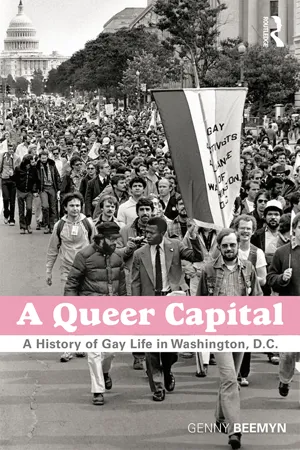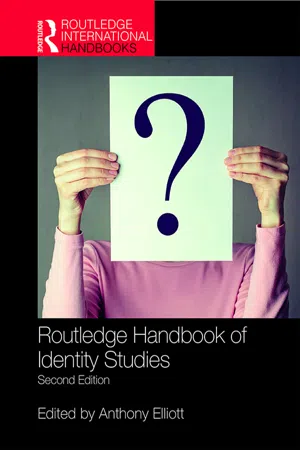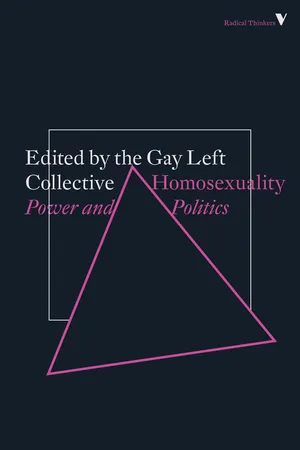History
1920s Gay Culture
The 1920s saw the emergence of a vibrant and underground gay culture in urban centers like New York, Paris, and Berlin. This period marked a time of increased visibility and social acceptance for LGBTQ individuals, with the rise of gay bars, clubs, and artistic communities. However, this cultural flourishing was also accompanied by widespread discrimination and persecution.
Written by Perlego with AI-assistance
Related key terms
6 Key excerpts on "1920s Gay Culture"
- eBook - ePub
- David M. Halperin(Author)
- 2012(Publication Date)
- Harvard University Press(Publisher)
There has been a massive transformation in the material base of gay life in the United States, and other metropolitan centers, during the past three decades. That transformation has had a profound impact on the shape of gay life and gay culture. It is the result of three large-scale developments: the recapitalization of the inner city and the resulting gentrification of urban neighborhoods; the epidemic of HIV/AIDS; and the invention of the Internet. In order to appreciate the nature of the change and its decisive, farreaching effects, we need to recall the conditions under which gay culture emerged in the years immediately preceding those three largescale developments. To begin with, gay liberation in the 1960s produced a wave of gay migration that by the 1970s had brought hundreds of thousands of gay men from all regions of the country to New York, San Francisco, Los Angeles, Chicago, Boston, Houston, Miami, and half a dozen other big cities. In particular, gay men moved from the comparative isolation of small towns or rural areas to specific urban districts, the so-called gay ghettos that were taking shape in major metropolitan centers. The concentration of large numbers of gay people in particular urban neighborhoods had decisive political, economic, and cultural consequences. It provided a power base for a gay political movement. It supported a large commercial infrastructure, including not only bars, bathhouses, and other unique sexual institutions, but also a local, community-based press and other forms of communication, 1 along with bookstores and coffeehouses. It created the kind of mass public that is essential to underwrite a flourishing cultural scene and to inspire constant political ferment. Finally, it produced queer communities freed from the surveillance of straight folks, where new kinds of collective reflection, consciousness-raising, cultural effervescence, and self-constitution could take place - eBook - ePub
Sexuality and Socialism
History, Politics, and Theory of LGBT Liberation
- Sherry Wolf(Author)
- 2017(Publication Date)
- Haymarket Books(Publisher)
52 Kinsey’s studies gave public expression to the reality of a growing gay minority in the United States. This was to have a profound impact on gays’ ability to mobilize for their rights. In the immediate postwar period gays in the United States went from complete isolation to developing an awareness of themselves as an oppressed class of people.As groundbreaking as these studies were in revealing the widespread presence of lesbian, gay, and bisexual people in U.S. society after the war, it is important not to take Kinsey’s figures as permanent and suprahistorical. Instead, what Kinsey’s studies and others since suggest is that LGBT people are not a fixed proportion of any society, but instead their ability to come out or for anyone to explore alternative sexual possibilities are largely shaped by fluctuating social and economic conditions. D’Emilio again sums up well the implications of this perspective:I have argued that lesbian and gay identity and communities are historically created, the result of a process of capitalist development that has spanned many generations. A corollary of this argument is that we are not a fixed social minority composed for all time of a certain percentage of the population. There are more of us than one hundred years ago, more of us than forty years ago. And there may very well be more gay men and lesbians in the future.53If the war opened up a vast space for the development of a gay community, the postwar period witnessed concerted attempts to close that space. The shifting needs of the American Empire, which emerged from the war a superpower, did in fact create both the conditions for heightened repression and sowed the seeds of opposition.There were strong economic and social incentives for ratcheting up harassment and legal discrimination against gays after the war. With U.S. industry churning out more than 60 percent of all manufactured goods in the world, the need for a higher birth rate to staff the labor force and military raised the idealization of the nuclear family to new levels. America’s new industrial prowess brought household appliances and a marketing blitz unknown to previous generations of workers. - eBook - ePub
A Queer Capital
A History of Gay Life in Washington D.C.
- Genny Beemyn(Author)
- 2014(Publication Date)
- Routledge(Publisher)
Race, Class, Gender, and the Social Landscape of the Capital’s Gay Communities During and after World War IIWorld War II is commonly considered a watershed event for gay people, resulting in a large increase in the number and visibility of lesbians, gay men, and bisexuals in cities such as Washington and a dramatic rise in the number of bars, restaurants, and other meeting places that they could frequent.1 As historian John D’Emilio states, “the unusual conditions of a mobilized society allowed homosexual desire to be expressed more easily in action. For many gay Americans, World War II created something of a nationwide coming out experience.”2 The war also seems to have been a transformative moment for many gay individuals who would be referred to today as drag queens; the creation of additional spaces where drag was accepted enabled them to discover and meet more readily with others like themselves.In the nation’s capital, the migration of both black and white people during and after World War II was instrumental to the formation of same-sex sexual communities, which developed both within and outside of existing, predominantly heterosexual, communities. More than at any previous time, those attracted to people of the same sex had opportunities to find each other and to socialize publicly together. Besides the proliferation of bars and the continued popularity of parks and other cruising locations, a growing number of house parties, late-night cafeterias, local drag events, and out-of-town drag balls provided gay individuals with places to meet in the 1940s and 1950s.But while histories of lesbian, gay, and bisexual people typically present the wartime and post-war migration to cities only in terms of its positive contributions toward the growth of explicitly gay communities and social institutions, I will demonstrate in this chapter that it had negative effects as well. In the nation’s capital, the massive influx often had a deleterious impact upon the atmosphere within existing gay bars, as their shifting clientele and greater visibility made them less safe for cruising. It is taken as a matter of course that the anonymity of the city helped facilitate same-sex sexual relationships, but for some prewar gay bar regulars, their lack of familiarity with the many new patrons made them leery. They could be even less certain that someone they met was not intending to assault and rob them or was a plainclothes police officer. For those who were also concerned about the public disclosure of their sexuality, the greater visibility of gay people in the 1940s and 1950s was not a welcomed change. Their sense of safety was dependent both on anonymity and on the ability to remain inconspicuous. - eBook - ePub
Routledge Handbook of Identity Studies
2nd edition
- Anthony Elliott(Author)
- 2019(Publication Date)
- Routledge(Publisher)
18Sexual identity-politics
Activism from gay to queer and beyond Mark CaseyIntroduction
This chapter focuses on the complex entwinement of sexual identity-politics and sexuality struggles for freedoms that emerged in the latter part of the twentieth century to the ongoing challenges, political movements and identity claims that minority sexual groups continue to experience in the early twenty-first century. The chapter primarily draws upon the experiences of sexual minorities in the United States and Western Europe due to the initial emergence of documented sexual politics within these locals. However, through the chapter’s approach it will become clear to the reader that claims around specific sexual identities, rights movements or historical events have to be understood through the specifity of geographical location, time, culture and the intersection of other identities present. This chapter will examine the important historical and intellectual developments which gay liberation and lesbian feminist movements gave birth to during the 1960s and 1970s. It will then move to discuss the advent of the HIV and AIDS crisis in the 1980s and the emergence of queer activism in the late 1980s and 1990s, in so doing the major claims and developments, and the contributions that queer political action provided in understandings of sexual identities, will be examined. The successes of the assimilationist agenda and normalising discourses in the late 1990s and early twenty-first century provide further analysis of current politicised claims and developments. Contributions made by the assimilationist agenda for understandings of ‘sexual citizenship’, particularly in the global north, will also be drawn upon. The main criticisms that can be framed around each of these key sexual minority movements will then be presented. In concluding, the chapter will offer an insight into future developments for sexual identities suggesting that citizenship rights struggles and gains in the global north, although potentially beneficial to many lesbians, gay men and heterosexuals, must not eclipse the material realities of those excluded from such ‘gains’ within the global north or the fragility of such rights. The growing identity movements and right-wing backlash to lesbian and gay ‘rights’ and identities in the global south, also need greater attention and consideration in the face of significant changes and challenges to the dominance of heterosexuality across the globe in recent years. - eBook - ePub
Boots of Leather, Slippers of Gold
The History of a Lesbian Community
- Elizabeth Lapovsky Kennedy, Madeline D. Davis(Authors)
- 2014(Publication Date)
- Routledge(Publisher)
The new social history of lesbians and gays, despite its emphasis on changing forms of gay politics, has tended to extend these earlier approaches and treat bar communities as an unchanging part of the gay landscape. When we began researching how the bar culture of the mid-twentieth century contributed to the formation of gay liberation, we also held a static model of bar culture. Our discoveries led us to tell a significantly different story: In the context of the changing social conditions of the twentieth century, lesbiarte acted to shape the possibilities for their future.The turn of the century was a time of transition for leisure-time activities. The nineteenth-century community and family-based forms of entertainment and relaxation were replaced by commercialized leisure. At the same time the homosocial forms of socializing, such as quilting parties, were supplanted by heterosocial forms, which brought young men and women together in movie houses, dance halls, and amusement parks.6 Kathy Peiss argues that this new leisure culture, while offering women some independence and autonomy in the pursuit of pleasure and romance outside of the strictures of their families, also institutionalized a restrictive heterosocial culture.7 Thus, while working-class lesbian culture of the 1930s could draw on a tradition of working-class women’s independent pursuit of fun and pleasure, it also by definition had to counter the powerful forces creating an exclusively heterosocial environment.For lesbians to establish a public social life was a challenge; each opportunity had to be created and persistently pursued. Bars were the only possible place for working-class lesbians to congregate outside of private homes. They were generally unwelcome in most social settings. Open spaces like parks or beaches, commonly used by gay men, were too exposed for women to express interest in other women without constant male surveillance and harassment. This was a time when it was still dangerous for unescorted women to be out on the street. In addition, many working-class lesbians could not even use their own homes for gatherings. If they were young they often lived with their parents, and once mature and living alone, most could not afford large apartments. Those who had apartments of an adequate size ran the risk of harassment from neighbors and/or the law should they entertain a large gathering. - eBook - ePub
Homosexuality
Power and Politics
- (Author)
- 2018(Publication Date)
- Verso(Publisher)
The traditional gay male culture was never knowingly political, and fully effective political movements have to be self-conscious movements. Nevertheless, this traditional culture did and does have political significance. It provided a space and, however maimed, a definition/recognition of homosexuality, and thus constituted one homosexual identity. There is real knowledge there, too. Directly, traditional gay culture has the capacity to see the constructedness of gender identities, to feel the sensuousness of role play and sexual behaviour, to respond to sensuousness and fun. We can also gain knowledge from it (if we pose the right questions of it) about how self-oppression works, the relation between culture and gender and so on. Finally, and not opportunistically, the fact is that many gay men are into this form of culture, for better or worse, and thus it is in a manner part of the constituency of gay politics. It is one of the languages in which propaganda can speak; it is one of the grounds in which the pleasure of politics can be rooted. Whatever its limitations, we have to work with it in order to move beyond it.RADICAL GAY CULTUREThe same period which saw the emergence of a self-defining, self-asserting “gay” identity, as opposed to a furtive or concealed “homosexual” one, also saw the beginnings of attempts to bring together the isolated experiences of lesbians and gay men that had for so long been separated. Visual, written and performance arts were seen as channels through which those who had “come out” and who had some positive things to say about their experiences as homosexuals could communicate to others, whether they were gay or not.This self-conscious culture differs from the traditional one, even when this is on rare occasions affirming of homosexuality, in its ability to look critically at our experiences without being condemning, to be self-aware rather than descriptive from the outside. The reason for this lies, most obviously, in the fact that the (homo)sexuality of the artists is an integral, rather than incidental or hidden aspect of the work. In the film Word is Out many of the lesbians and gay men who spoke about their experiences talked of the role-playing that, used to go on between gay couples, and as a viewer I felt that these gay people were not putting down those experiences, but speaking from a more self-aware, less constrained position. The lesbian theatre group Hormone Imbalance’s satire of lesbian stereotypes extended well beyond their name (a reference to a supposed cause of lesbianism) to a chilling song by Lottie and Ada called “You don’t know what it’s like to be revolting” portraying the very worst fears of what lesbians are like: predatory, deranged, “dildo users, child abusers…”. The Brixton Faeries’ play about the Jeremy Thorpe case, Minehead Revisited
Learn about this page
Index pages curate the most relevant extracts from our library of academic textbooks. They’ve been created using an in-house natural language model (NLM), each adding context and meaning to key research topics.





